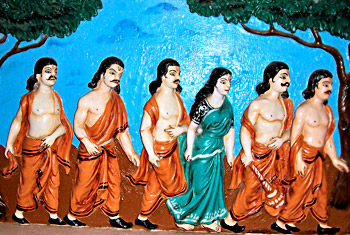 Yavana Kingdom was grouped under western countries which also included Sindhu, Madra, Kekeya, Gandhara and Kamboja as mentioned in the epic Mahabharata. This word was used to indicate the Greeks and the Arabs in later history. The name Yavana probably could be the Sanskritized form of the name Ionia. Some believe that the name Ionia originated from the Sanskrit word Ayonija which means one who born not from a human womb or people with extra ordinary origins.
Yavana Kingdom was grouped under western countries which also included Sindhu, Madra, Kekeya, Gandhara and Kamboja as mentioned in the epic Mahabharata. This word was used to indicate the Greeks and the Arabs in later history. The name Yavana probably could be the Sanskritized form of the name Ionia. Some believe that the name Ionia originated from the Sanskrit word Ayonija which means one who born not from a human womb or people with extra ordinary origins.
An account in the epic says that Yavanas were the descendants of Turvusu, one of the cursed sons of king Yayati. He was given a part of the world known to be Turkey, to rule. Therefore the Turks are considered as Yavanas as they were the descendants of Maharaja Yavana. The Yavanas belonged to the Kshatriya clan. Later on the Brahmanical culture was discarded and they became mleccha-yavanas. The Yavanas along with the Anavas had established themselves in the western regions.
Epic of Mahabharata considers the technological knowledge of the Yavanas. They were omniscient. The rulers of Yavana kingdom might have spread throughout ancient India, who established their small kingdoms during the period of Mahabharata. Ancient Indian warriors like Pandu, Arjuna, Nakula, Sahadeva, Karna and Lord Krishna were mentioned as encountering Yavana kings.
There has been a mention of a Yavana strong-hold in Mathura. The Yavanas who lived around Mathura were skilled in fighting with bare arms. The Yavanas with the followers were all defeated by Krishna. King Bhagadatta who was the ruler of Pragjyotisha in Assam is talked about as a Yavana king in some passages of Mahabharata.
In the Kurukshetra war the Yavanas supported the Kauravas under the Kamboja king Sudakshina. Yavanas were armed with bow and arrows and skilled in smiting.
This article is a stub. You can enrich by adding more information to it. Send your Write Up to content@indianetzone.com



















